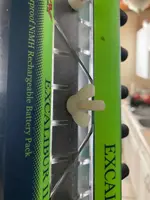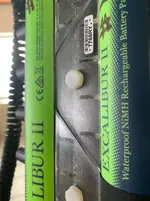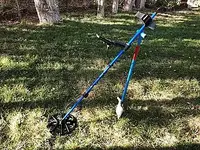Wow -- you all are just terrific! THANK YOU -- each of you!
Iron Buzz, I will try to answer your specific questions, but in the mean time, everyone sort of "took care of it" already, by chiming in! THANK YOU, everyone!
I'll throw a few more thoughts out there...
Complete shaft, or just the lower rod? Both are available, either "standard," or "customized" to your specific needs (I've done ALL KINDS of custom shafts -- three-piece shafts, tall-man rods, dive shafts, shafts to fit specific cases/carriers, etc.) But, obviously the most popular, that works well for most, is the standard, complete shaft.
Long or short counterweight? I build these based on each customer's needs -- based on their feedback as to how the Equinox "feels" to them, and what issues they are experiencing (if any). Obviously, longer tubes have a higher maximum weight capacity, with the small downside for some being the extra length; the idea is to find that "sweet spot" -- keeping the balance as short as possible, but not TOO short, such that the weight capacity is insufficient to achieve the balance necessary for that specific person. Some EQX users don't need counterweighting, some need "some," and some need a whole lot. I "consult" with each customer, at purchase time, to narrow it down based on their specific needs. Another note -- there is flexibility here, too, since the counterweights themselves are "adjustable," in terms of how much weight is installed (via the removable cap, on the tube). So, user experimentation, AFTER purchase, allows each individual to hone in on the amount of weight that works best. There is a blog entry on my website, in the "blog" section under the "What's New" tab, that addresses this very question, in detail (
www.stevesdetectorrods.com/blog/index.php)
Button holes or no button holes? Great question! I designed the shaft
specifically to ELIMINATE the need for button holes. That was a main objective, and to accomplish that, it required a specific, heavy-duty, adjustable clamp-type cam lock. The cam lock was a MAJOR focus of my design, because eliminating those pesky button holes on the shaft was important to me --
one, because they are tedious/cumbersome to use, and
two, because they force you into limited, fixed adjustment lengths on your lower rod. That is unnecessarily restrictive. A proper cam lock ELIMINATES the need for the button holes, as the only reason many shafts include them is because the cam locks being used (those twist locks) are not heavy-duty enough to achieve a sufficiently secure connection of the shaft sections
by themselves. But a proper, clamp-type cam lock does NOT require any "extra help," in terms of connection stability, and thus eliminates the need for the button/button-hole design (as illustrated by Minelab's CTX 3030, E-Trac, Safari, and Explorer series, XP's Deus, Tarsacci's MDT-8000, and others, that employ a "proper" cam lock, and thus no spring button/button holes required).
SO -- why do I even offer the button holes? The reason is because I have had occasional customers who specifically WANT them, for whatever reason, and to accommodate, I do keep the button holes as an available option, on the black shafts. Otherwise, my "standard" shaft does not include them, as that was the original design intent of my shaft.
I should note here, though, that I usually DO include a spring button on my lower rods, just so that the rod is compatible with Minelab's stock shaft, should anyone wish to utilize that option. But when used with my "hole-less" shaft, the button just remains depressed/"pushed in," while inside the shaft, and behaves as if it is not even there.
Customers who opt for the standard "hole-less" shaft seem to love the cam lock, they appreciate not having to mess with the button, and appreciate the easy/quick/unlimited adjustability of the lower rod length that results. I also wrote an extensive piece on this specific subject, as well, in my website's blog section (it's the entry right underneath the "counterweight" entry -- and again the blog resides at
www.stevesdetectorrods.com/blog/index.php.
What does "counterbalance-ready" mean? As others have stated, it just means that the shaft comes with a threaded fitting installed in the butt-end, which permits the attachment of the optional counterweight. Otherwise, the shaft is identical to a "standard" shaft. The "standard, or "non-counterweight-ready" shaft comes with a regular rubber end cap; the "counterweight-ready" shaft, with that threaded fitting installed, includes a
threaded end cap, which thus allows the shaft to be "capped" whenever the counterweight is not attached.
Some folks prefer to order just the "counterweight-ready" shaft initially, without the counterweight (especially new Equinox users who aren't yet sure how the unit's imbalance might or might not affect them, as well as those who may be planning to purchase the 12" by 15" coil later on, but are concerned about the extra nose-heaviness that will result). That way, having the shaft "ready" to accept counterweight attachment, they leave the option open to purchase the counterbalance later, if necessary, once they have the time to figure out if swinging the EQX causes them any ergonomic issues.
Anything else you might need to know? I'd say the only other things that may be good to know, are
1). whether you have any interest in a colored carbon-fiber shaft, as opposed to standard black,
2). if you have any specific needs for shaft customization, beyond what the "standard" shaft offers, and
3). whether you have any interest in upgrading to a Jeff Herke aluminum arm cuff (and optional, padded neoprene cuff cover). The "Herke" cuffs are nice, powder-coated, heavy-duty cuffs, that integrate seamlessly with my upper shaft.
We can discuss any of these options during the purchase process.
If you are unsure of what to order, and asked for my recommendation, I would typically suggest, for the average customer, a black, counterweight-ready shaft, no button holes, and -- if they have multiple coils -- ONE extra lower rod (as the Minelab lower rod can be used perfectly, with my shaft system). This is a very flexible, and yet relatively cost-effective option that would allow you a lower rod for all three coils, AND the ability to add a counterweight -- either at time of purchase, or at any time down the road. A cuff could also be added later, if/when the need arose.
I hope, Iron Buzz, that this lengthy mess of words answers most or all of your questions -- and they are good questions, as I have had others, at times, that also are unsure of what exactly they might wish to order. THANK YOU for asking, and for your interest!
Steve
www.stevesdetectorrods.com
www.facebook.com/stevesdetectorrods
email: steve@stevesdetectorrods




